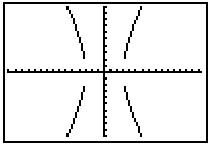Solve the problem.If n(A ? B) = 56, n(A ? B) = 26, and n(A) = n(B), find n(A).
A. 28
B. 41
C. 13
D. 15
Answer: B
You might also like to view...
Solve the problem.Larry has $1500 to invest and needs $1900 in 14 years. What annual rate of return is required for him to accomplish his goal, if interest is compounded continuously? (Round your answer to two decimals.). Use the formula A = Pert.
A. 1.41% B. 3.41% C. 1.69% D. 2.41%
Find the present value. Round to the nearest cent.To get $10,500 after15 years at 8% compounded annually
A. $3152.42 B. $3310.04 C. $3574.84 D. $7189.96
Factor the polynomial as the sum or difference of two cubes.x3 + 8
A. (x + 2)(x2 + 4) B. (x - 8)(x2 - 1) C. (x + 2)(x2 - 2x + 4) D. (x - 2)(x2 + 2x + 4)
The hyperbola shown in the calculator-generated graph was graphed in function mode with a square viewing window. What are the two functions y1 and y2 that were used to obtain the graph whose equation is given? 10
10

 -10
-10
A. y1 = 6 , y2 = -6
, y2 = -6
B. y1 = 6 , y2 = -6
, y2 = -6
C. y1 = 6 , y2 = -6
, y2 = -6
D. y1 = 3 , y2 = -3
, y2 = -3